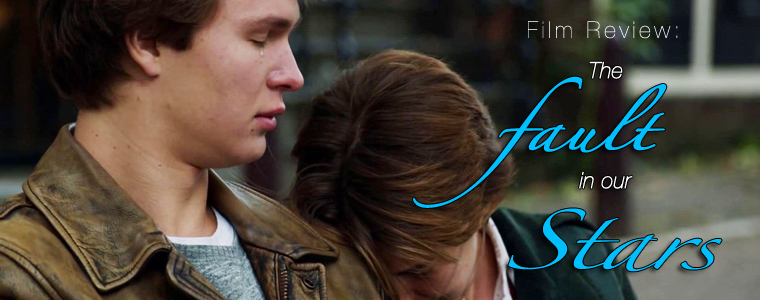Star-Crossed Chemo
by Andrew Collins
The Fault in Our Stars explores the psyche of the teenage cancer patient. For those of us whose inner circle has not been visited by the Big C, encounters with cancer can tend toward the distant — a sentimental charity ad, a scripted request at the grocery store checkout. We tut-tut the horrors of the largely incurable killer, pat ourselves on the back for dropping a few bucks on a 5K now and then, and heap praise on celebrities for taking pictures with tragically sick children.
The Fault in our Stars plunges us into a more intimate perspective. Seeing from the inside out — through the eyes of a cancer-stricken seventeen year-old — the film declares that whole business a load of bull.
That’s where this film sets the hook. Through the mind of Hazel (Shailene Woodley), it blasts the sentimentality of a cancer kids culture – the “Republic of Cancervania,” as she calls it – with cold cynicism and black humor.
“Depression,” she notes in a brilliant early line, “is not a side effect of cancer. Depression is a side effect of dying.”
The film is an adaptation of a book by the rising YA literature phenom John Green. The big-screen version preserves the book’s criticism and faithfully captures some of the original charm. But it strays from the original story’s deadpan confrontation with oblivion by glossing over everything — ironically enough — with a veneer of Hollywood sentimentality. It challenges the conventions of the cancer-kid, teen-romance genre, but only to a point.
Put it this way: If Hazel was a real person, rolling her eyes at her support group meetings and eking her way through life on half-drowned lungs, she would despise this film’s portrayal of herself.
There are two main reasons for this.
As its first, and perhaps greatest, flaw, The Fault in Our Stars does not include any reference to its title. In the book the title is explained when Hazel’s favorite author, Peter Van Houten, quotes Shakespeare’s Cassius noting, “The fault, dear Brutus, is not in our stars / But in ourselves.”
Van Houten (Willem Dafoe) disagrees with this perspective. “Were she better or you sicker, then the stars would not be so terribly crossed, but it is the nature of stars to cross, and never was Shakespeare more wrong,” he writes to Hazel’s love-interest Augustus (Ansel Elgort) in a letter. “There is no shortage of fault to be found amid our stars.”
When reading, I found this to be a tipping point – the moment when I realized I had a good story on my hands. In the theater, I found no such moment. The film features the star motif throughout (there are stars on Hazel’s bedroom ceiling, for example) but Shakespeare’s line never appears — despite copious text message and email reading.
This idea that fate, more so than ourselves, has a knack for screwing us over could have hit us with more oomph with the simple inclusion of this literary reference. This point, after all, is what makes the story so powerful.
[Spoiler Alert]
The “crossed” stars of a healthy Augustus and sickly Hazel become “uncrossed,” in a narrative sense, when Augustus’ cancer relapses and they both become grenades, destined sooner rather than later to explode in emotional shrapnel. Thus their lives become exponentially more painful, but it is only through this level-10 pain that Hazel learns how to experience love. The pain is not just a catalyst, but the absolutely necessary catalyst to her transformation.
Also problematic in the film is that the cancer kids didn’t look, well, sick enough. Chalk it up to weak acting at key moments. Chalk it up to Hollywood’s compulsive need to make its protagonists beautiful people. I suspect the latter more, but in any case, when Augustus is a week away from death, he should look in significantly worse shape than at the beginning of the film (beyond simply sitting in a wheelchair). The sickly pale, the lined faces, the weary eyes, the 24/7 efforts to simply keep breathing touch our protagonists in only a handful of moments.
That said, the film — thankfully — does not obscure one central notion of the story: that some infinities are longer than others.
“You gave me a forever within the numbered days,” Hazel says, “and I’m grateful.”
Set in almost any other romantic context, this would come across as cheese. Yet against the backdrop of oblivion, among two lives cut unnaturally short by an absurdity of nature, it calls us to number our days.
Most importantly, it makes us care. When two lovers won’t survive for even a score of years, the notion that teenagers can fall truly in love becomes a lot more plausible.
And where love is plausible in a story, it is beautiful.








